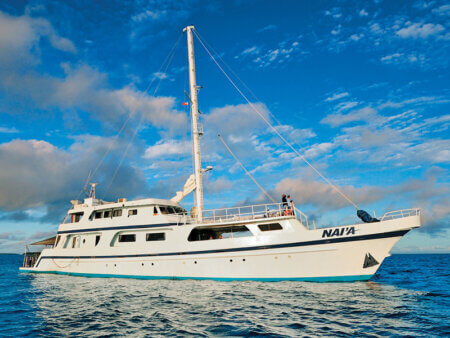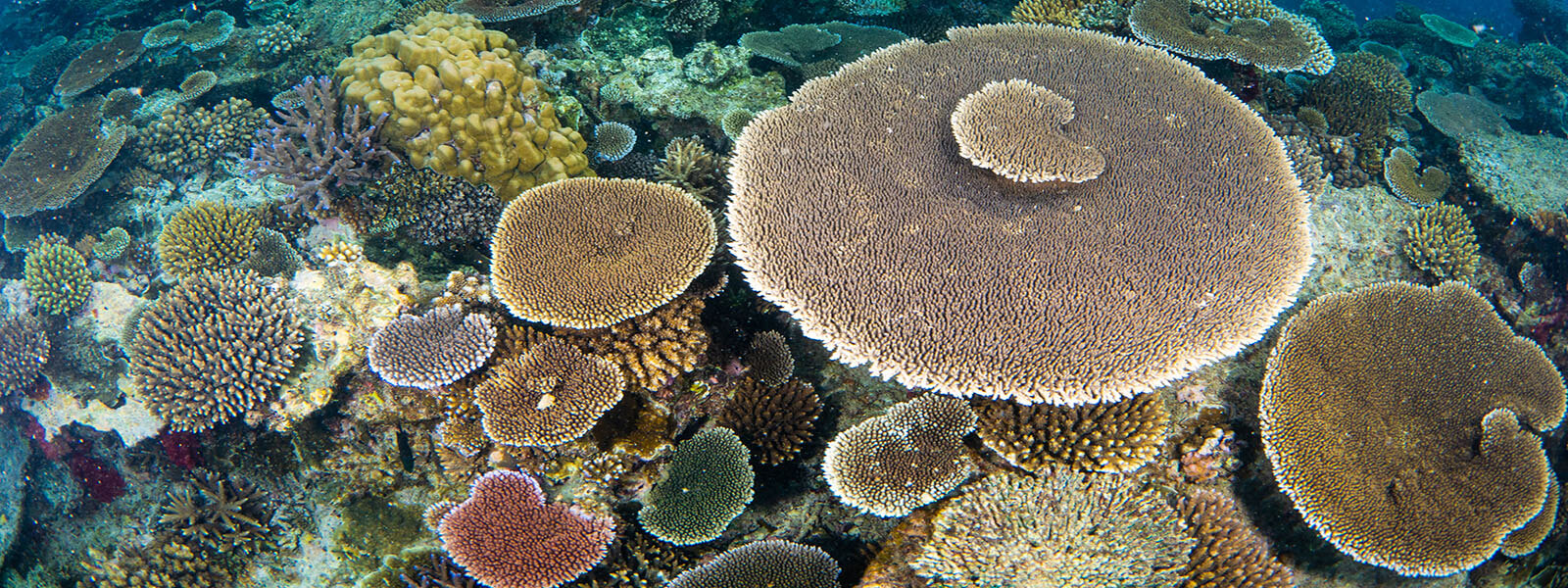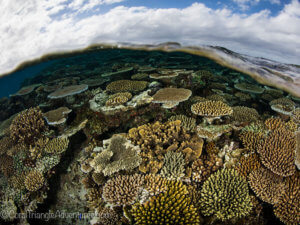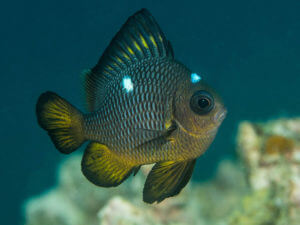The soft coral capital of the world!
 Fiji! It conjures up images of the perfect South Pacific island paradise: Coconut-lined, white sand beaches that flow seamlessly into warm, azure blue seas. The Republic of Fiji is a cluster of about 332 islands—160 are inhabited—and over 500 tiny islets that falls between 16º and 18º south of the Equator. The two main islands, Viti Levu and Vanua Levu account for almost 75 percent of the total land mass and possesses nearly 90 percent of the population (last estimated to be nearly one million people). Born of fire, Fiji is mostly volcanic in origin and has lush tropical jungles that cover mostly rugged terrain.
Fiji! It conjures up images of the perfect South Pacific island paradise: Coconut-lined, white sand beaches that flow seamlessly into warm, azure blue seas. The Republic of Fiji is a cluster of about 332 islands—160 are inhabited—and over 500 tiny islets that falls between 16º and 18º south of the Equator. The two main islands, Viti Levu and Vanua Levu account for almost 75 percent of the total land mass and possesses nearly 90 percent of the population (last estimated to be nearly one million people). Born of fire, Fiji is mostly volcanic in origin and has lush tropical jungles that cover mostly rugged terrain.x
Though Fiji falls just outside the boundary that defines the Coral Triangle, the diversity of marine life as astoundingly high. It has been reported that Fiji possesses nearly 1500 species of tropical fish and almost 400 species of hard corals. Fiji has a good variety of habitats including shallow coral gardens that showcase the incredible diversity of hard corals and fish in the area, current-swept passages that offer exhilarating drift snorkels over the world famous soft corals that display a kaleidoscope of colors, and seaward reefs where big fish such as groupers, sharks, and turtles can be found. If it’s a South Pacific paradise you seek, please join us for this amazing snorkeling tour to one of the world’s most beautiful tropical island destinations!
ITINERARY
 The tour begins and ends in Nadi, Fiji. Please note this tour is an exploratory expedition. Though we have had a Fiji snorkeling tour in 2016 (Beqa Lagoon, south Viti Levu), this program will spend most of our time in northern Viti Levu (east and west) and around the Mamanuca and Yasawa Island groups. Please note that although we visit many of the islands and island groups in the sample itinerary below, each of our departures is unique and that weather, tides, and opportunities to explore all play a role in the decisions about our daily schedule as well as the overall itinerary.
The tour begins and ends in Nadi, Fiji. Please note this tour is an exploratory expedition. Though we have had a Fiji snorkeling tour in 2016 (Beqa Lagoon, south Viti Levu), this program will spend most of our time in northern Viti Levu (east and west) and around the Mamanuca and Yasawa Island groups. Please note that although we visit many of the islands and island groups in the sample itinerary below, each of our departures is unique and that weather, tides, and opportunities to explore all play a role in the decisions about our daily schedule as well as the overall itinerary.
Day 1: Fiji / Nadi / Fiji Resort
Meals provided: D
Arrive in Nadi, Fiji check in at the group resort. Welcome dinner and trip orientation at the resort. Overnight Radisson Blu, Denarau Island.
Day 2: NAI’A / Yasawa Islands
Meals provided: B,L,D
In the late morning, we’ll transfer to our live-aboard boat, the NAI’A and cruise towards the Yasawa Islands, a small archipelago of island that lie just off shore to the northwest. Like many of the islands in Fiji, the Yasawas are a series of lush volcanic islands footed by white sand beaches and surrounded by fringing reefs that are full of life. We’ll snorkel some of the reefs along the southern tip of the archipelago and take advantage of the classic shallow fringing reef before heading out to the barrier reefs and atolls. Overnight Nai’a
Day 3 – 5: Vitu-i-ra Passage
Meals provided: B,L,D
Vita-i-ra is the narrow channel between Viti Levu and Vanua Levu. Within the channel lie a network of atolls and barrier reefs that support a huge number of fish and invertebrates. Habitat include shallow seaward facing reefs and drop-offs, protected inner lagoons, and current-swept passages where brisk water movement brings out the colorful soft corals that Fiji is known for. We’ll spend the next few of days exploring these habitats, snorkeling with sharks, rays, turtles, and the thousands of reef fish that dwell there. Overnight Nai’a
Day 6 – 8: Makogai Island / Wakaya Island / Gau Island
Meals provided: B,L,D
Each of these barrier islands are encapsulated by their ‘own’ barrier reef, though a narrow ridge of coral connects the two systems. Steep drop-offs plunging to thousands of feet attract a variety of pelagic marine life from whales to mantas to sharks, and though we will keep an eye out for them, it’s the reef that will keep our attention. Within the lagoon, we will spend time around dozens of large, coral-encrusted bommies and look for smaller critters like pipefishes, nudibranchs, octopus, and scorpionfishes. Gau Island is one of the larger islands along the eastern side of Viti Levu and is surrounded by a barrier reef that fringes along the east side. Overnight Nai’a
Day 9 – 10: Lovoni Island / Vitu Levu
Meals provided: B,L,D
Lovoni Island is sits about ten miles offshore, but within the barrier reef that encapsulates the main island of Viti Levu along the northeast coast. Shallow coastal reefs will give us the chance to explore protected reefs, sea grass and mangroves communities. Overnight Nai’a
Day 11: Mamanuca Islands / Lautoka
Meals provided: B,L,D
Located just offshore from Nadi, the Mamanuca islands are a group of 20 islands, some that are fully submerged at high tide. The shallow hard coral-dominated reefs that fringe from white sand beaches. In the evening, we’ll begin our cruise back to the port at Lautoka. Overnight Nai’a
Day 12: International flights or extensions
Meals provided: B
DEPARTURES
Feb 20 – Mar 03, 2026 ←Click to request a booking
Accommodations: M/V Nai’a
Guides: Ethan Daniels, Lee Goldman
Length: 12 days
Prices and Payment schedule:
$8700 USD per person, double or twin-share occupancy
Reservation deposit: $1000 USD
August 20, 2025: $4700 USD
November 20, 2025: $3000 USD
Tour cost includes:
- Accommodations on day 1 through day 12
- All meals on days 2 through 11 (dinner on day 1 – breakfast on day 12)
- All internal transfers including international arrival and departure transfers
- Non-alcoholic beverages
- All snorkeling and park fees
- All gratuities
Tour cost does not include:
- Round-trip international airfare
- Additional hotel accommodations and meals as a result of travel outside of the program dates
- Visa requirements including payments
- Alcoholic beverages
- International departure taxes
- Extra / overweight baggage fees
- Trip insurance (recommended; (we recommend Travel Guard, World Nomads, or Travel Insure)
- DAN insurance (required unless personal insurance program has worldwide emergency evacuation services)
- Additional accommodations while on tour in the event of flight schedule changes or events of force majeure
- Fuel surcharges (if applicable)
Cancellation policy:
180 – 91 days prior to departure: 50% of trip cost
90 days or less prior to departure: 100% of tour cost
Please see our Terms and Conditions
ACCOMMODATIONS
We use the luxurious NAI"A live-aboard to host us on our snorkeling adventures in Fiji. Please visit our accommodations page for more photos or use the link to visit the resort/live-aboard website.
NAI'A
 NAI'A has set new standards of live-aboard luxury since her launch in 1993. Designed and built in Holland, NAI’A is 120ft long and 30ft wide with nine air-conditioned staterooms, each with ensuite bathrooms, a large dive deck, camera room, a spacious saloon/lounge, and plenty of deck space to relax and enjoy warm tropical breezes. Meals consist of international dishes as well a local Fijian cuisine. A solid expeditionary ship, she has the range and stability to sail the far reaches of the Pacific and has travelled from her base in Fiji to Vanuatu and New Caledonia, Tonga, Samoa, Tuvalu, Funafuti and the Phoenix Islands in Kiribati. More photos
NAI'A has set new standards of live-aboard luxury since her launch in 1993. Designed and built in Holland, NAI’A is 120ft long and 30ft wide with nine air-conditioned staterooms, each with ensuite bathrooms, a large dive deck, camera room, a spacious saloon/lounge, and plenty of deck space to relax and enjoy warm tropical breezes. Meals consist of international dishes as well a local Fijian cuisine. A solid expeditionary ship, she has the range and stability to sail the far reaches of the Pacific and has travelled from her base in Fiji to Vanuatu and New Caledonia, Tonga, Samoa, Tuvalu, Funafuti and the Phoenix Islands in Kiribati. More photos
Fiji Resort
WHAT TO EXPECT
Fiji experiences a warm, tropical climate throughout the year with average daily temperatures hovering around 26º C (80º F). Water temperatures average around 28º C (82º F), though influxes of cooler surface waters can be experienced at any time. We scheduled our tour to take advantage of the month that usually experiences the least amount of wind, though we might expect a few more days of afternoon showers than during months in the cooler dry season. We recommend full 3mm wetsuits and having a hood is also important not only for thermal protection, but as a barrier against the sun. At a minimum, please have a full dive skin (such as lycra or more advanced materials like Lavacore). to help with protection against the sun as well as the random no-see-um stingies that are part of the plankton community.
Please read more about our daily schedule.
WHAT TO BRING
The following list is a suggestion of things to bring and applies to almost all our trips. Specific items on a particular departure will be noted on the departure information.
-A good fitting mask, snorkel, and set of fins. If your equipment is brand new, please try it out in the pool. Determining the fit and function of your equipment in the pool includes doing several laps with all your equipment on. Doing several snorkel dives is also very beneficial. It is also important to clean your new equipment, especially your mask. Cleaning procedures for your mask include light scrubbing with toothpaste or dishwasher soap to remove the layer of silicon used to preserve the mask during shipping. Clean both sides of the mask. Doing this greatly reduces the chances of having your mask fog. Not doing this, even when using mask de-fogger, usually results in a fogged mask.
-A wetsuit, rash guard, diveskin, or any type of clothing that can be used for thermal and/or protection from the sun. We suggest bringing a full 3mm wetsuit and some type of core insulation like a vest or shirt made of 1 – 2 mm neoprene (e.g., Lavacore or Sharkskin shirts or vests). These items will not only provide thermal protection but protection from the sun as well. For those who feel that a 3mm suit may be too warm, please consider a full body skin or rash guard to ensure protection from the sun. With regards to thermal protection, remember the saying: It is better to have and not need, than to need and not have. One that note…
-Head protection in the form of a wetsuit hood, a cap, or even a bandana. Anything that can keep the sun off your head is extremely important. It is the most exposed part of our bodies when we are floating on the surface.
-Underwater flashlight on departures with a planned night snorkel
-Biodegradable sunscreen lotion. Sunscreen lotions can be harmful and even kill tiny larvae (baby marine life). It is fine to wear on land, but we highly discourage the use of sunscreen lotions in the water. A full wetsuit or dive skin will protect one from the sun much better than lotions and provide thermal protection. It is truly a win-win for everyone and the marine environment.
-Casual, lightweight, tropical clothing
-Sunglasses (and a spare in case you lose your main pair)
-Comfortable footwear such as active sandals (Teva, Keen, Merrell, etc.)
-Hats. We cannot stress the importance of a hat in the tropics!
-All our boats provide items like shampoo, soap, towels, etc. We bring this up because these items represent added weight or may leak.
Other items to consider:
-Lightweight rainwear to protect from the occasional afternoon shower
-Binoculars
TRIP REPORTS





